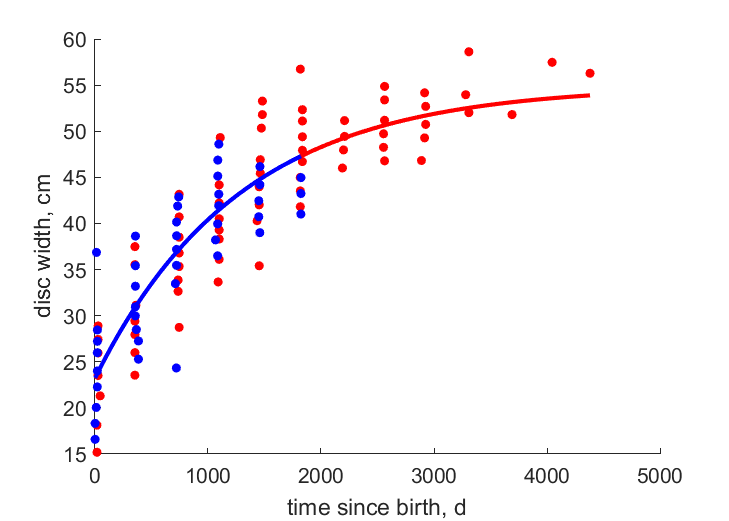Predictions & Data for this entry
| Model: std | climate: MB | migrate: Mo | phylum: |
| COMPLETE = 2.5 | ecozone: MPNW | food: biCi | class: |
| MRE = 0.089 | habitat: 0iMb | gender: D | order: |
| SMSE = 0.013 | embryo: Mv | reprod: O | family: |
Zero-variate data
| Data | Observed | Predicted | (RE) | Unit | Description | Reference |
|---|---|---|---|---|---|---|
| ab | 365 | 371.1 | (0.01681) | d | age at birth | YamaKume2009 |
| am | 4380 | 4380 | (2.203e-05) | d | life span | KumeFuru2008 |
| Lb | 21 | 23.27 | (0.1081) | cm | total length at birth | KumeFuru2008 |
| Lp | 42.1 | 41.38 | (0.01704) | cm | total length at puberty | YamaKume2009 |
| Lpm | 39.3 | 39.32 | (0.0003966) | cm | total length at puberty for males | YamaKume2009 |
| Li | 68 | 70.23 | (0.03275) | cm | ultimate total length | fishbase |
| Wwi | 8300 | 8268 | (0.003805) | g | ultimate wet weight | Neer2005 |
| Ri | 0.01644 | 0.01603 | (0.02483) | #/d | maximum reprod rate | YamaKume2009 |
Uni- and bivariate data
| Data | Figure | Independent variable | Dependent variable | (RE) | Reference |
|---|---|---|---|---|---|
| tL_f |   | time since birth | disc width | (0.08163) | KumeFuru2008 |
| tL_m |   | time since birth | disc width | (0.1083) | KumeFuru2008 |
Pseudo-data at Tref = 20°C
| Data | Generalised animal | Platyrhina sinensis | Unit | Description |
|---|---|---|---|---|
| v | 0.02 | 0.02369 | cm/d | energy conductance |
| p_M | 18 | 18.22 | J/d.cm^3 | vol-spec som maint |
| k_J | 0.002 | 0.002 | 1/d | maturity maint rate coefficient |
| k | 0.3 | 0.5741 | - | maintenance ratio |
| kap | 0.8 | 0.5462 | - | allocation fraction to soma |
| kap_G | 0.8 | 0.8 | - | growth efficiency |
| kap_R | 0.95 | 0.95 | - | reproduction efficiency |
Discussion
- The cost for milk secretion is added to the investment from the reproduction buffer.
- Males are supposed to differ from females by E_Hp only
Facts
- At first, they are enclosed in an egg case while the developing embryos feed on the yolk. After the egg hatches, the pup remains in the oviduct and receives nourishment from a milky secretion (Ref: fishbase)
Bibliography